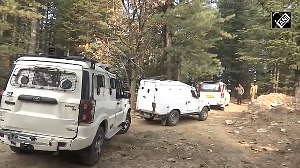 NASA's Mars rover 'Curiosity' has fired its laser for the first time on the red planet, using the beam from a science instrument to interrogate a fist-size rock.
NASA's Mars rover 'Curiosity' has fired its laser for the first time on the red planet, using the beam from a science instrument to interrogate a fist-size rock.
The mission's Chemistry and Camera instrument, or ChemCam, hit the rock called 'Coronation' with 30 pulses of its laser during a 10-second period, NASA said in a statement.
The technique used by ChemCam, called laser-induced breakdown spectroscopy is the first use of the technique in interplanetary exploration.
It has been used to determine composition of targets in other extreme environments, such as inside nuclear reactors and on the sea floor, and has had experimental applications in environmental monitoring and cancer detection.
The energy from the laser excites atoms in the rock into an ionized, glowing plasma. ChemCam catches the light from that spark with a telescope and analyses it with three spectrometers for information about what elements are in the target.
"We got a great spectrum of Coronation - lots of signal," said ChemCam Principal Investigator Roger Wiens of Los Alamos National Laboratory, New Mexico.
"Our team is both thrilled and working hard, looking at the results. After eight years building the instrument, it's payoff time!" Wiens said.
ChemCam recorded spectra from the laser-induced spark at each of the 30 pulses. The goal of this initial use of the laser on Mars was to serve as target practice for characterising the instrument, but the activity may provide additional value.
Researchers will check whether the composition changed as the pulses progressed. If it did change, that could indicate dust or other surface material being penetrated to reveal different composition beneath the surface.
The spectrometers record intensity at 6,144 different wavelengths of ultraviolet, visible and infrared light.
"It's surprising that the data are even better than we ever had during tests on Earth, in signal-to-noise ratio," ChemCam Deputy Project Scientist Sylvestre Maurice of the Institut de Recherche en Astrophysique et Planetologie (IRAP) in Toulouse, France said.
"It's so rich, we can expect great science from investigating what might be thousands of targets with ChemCam in the next two years," Maurice added.
Curiosity landed on Mars two weeks ago, beginning a two-year mission using 10 instruments to assess whether a carefully chosen study area inside Gale Crater has ever offered environmental conditions favourable for microbial life.
Photograph: This composite image, with magnified insets, depicts the first laser test by the Chemistry and Camera, or ChemCam, instrument aboard NASA's Curiosity Mars rover on Mars in this Nasa handout photo.
Credit: Reuters/NASA/JPL-Caltech/MSSS/LANL/Handout





